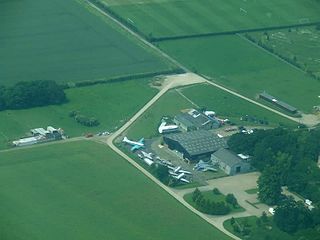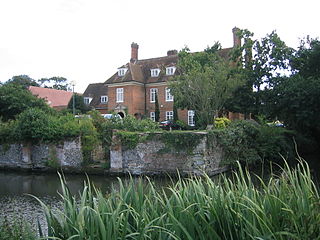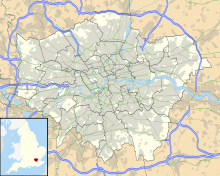
The de Havilland Aircraft Company Limited was a British aviation manufacturer established in late 1920 by Geoffrey de Havilland at Stag Lane Aerodrome Edgware on the outskirts of north London. Operations were later moved to Hatfield in Hertfordshire.

Captain Sir Geoffrey de Havilland, was an English aviation pioneer and aerospace engineer. The aircraft company he founded produced the Mosquito, which has been considered the most versatile warplane ever built, and his Comet was the first jet airliner to go into production.

The de Havilland DH.82 Tiger Moth is a 1930s British biplane designed by Geoffrey de Havilland and built by the de Havilland Aircraft Company. It was operated by the Royal Air Force (RAF) and other operators as a primary trainer aircraft. In addition to the type's principal use for ab initio training, the Second World War had RAF Tiger Moths operating in other capacities, including maritime surveillance and defensive anti-invasion preparations; some aircraft were even outfitted to function as armed light bombers.

The de Havilland Aircraft Museum, formerly the de Havilland Aircraft Heritage Centre, is a volunteer-run aviation museum in London Colney, Hertfordshire, England.

The de Havilland DH.84 Dragon is a successful small commercial aircraft that was designed and built by the de Havilland company.

The de Havilland DH.60 Moth is a 1920s British two-seat touring and training aircraft that was developed into a series of aircraft by the de Havilland Aircraft Company.

Geoffrey Raoul de Havilland Jr., OBE was a British test pilot. He was the son of Geoffrey de Havilland, the English aviation pioneer and aircraft designer.

Panshanger Aerodrome was a former general aviation aerodrome located on the most eastern tip of Welwyn Garden City, Hertfordshire, England, 2.5 NM west of Hertford, East Hertfordshire.

The de Havilland DH.61 Giant Moth was a 1920s British large single-engined biplane transport built by de Havilland at Stag Lane Aerodrome, Edgware. Intended primarily for use in Australia, a number were also shipped to Canada.

The de Havilland DH.94 Moth Minor was a 1930s British two-seat tourer/trainer aircraft built by de Havilland at Hatfield Aerodrome, England. With the start of the second world war production of the Moth Minor was moved to de Havilland Australia at Bankstown Aerodrome, Australia.
The de Havilland Moths were a series of light aircraft, sports planes, and military trainers designed by Geoffrey de Havilland. In the late 1920s and 1930s, they were the most common civilian aircraft flying in Britain, and during that time every light aircraft flying in the UK was commonly referred to as a Moth, regardless if it was de Havilland-built or not.
Hatfield Aerodrome was a private airfield and aircraft factory located in the English town of Hatfield in Hertfordshire from 1930 until its closure and redevelopment in the 1990s.

London Air Park, also known as Hanworth Air Park, was a grass airfield in the grounds of Hanworth Park House, operational 1917–1919 and 1929–1947. It was on the southeastern edge of Feltham, now part of the London Borough of Hounslow. In the 1930s, it was best known as a centre for private flying, society events, visits by the Graf Zeppelin airship, and for aircraft manufacture by the Whitehead Aircraft Company during World War I and General Aircraft Limited (GAL) 1934–1949; in total over 1,650 aircraft were built here.

The de Havilland Aeronautical Technical School was founded in 1928, initially to provide owners of de Havilland Moth aircraft with technical maintenance skills.
Marden Airfield was an airfield in Marden, Kent, United Kingdom. It was operation from 1917 to 1935. Initially a Royal Flying Corps airfield during the First World War it was used post-war as an Emergency Landing Strip, RAF Marden by the Royal Air Force. It was also known as Pagehurst Emergency Landing Ground. Later serving as a civil Emergency Landing Ground, the airfield closed in 1935. The site housed a Royal Air Force transmitter station during the Second World War.
Luskintyre Airfield is a private aerodrome in the Hunter Valley of New South Wales, Australia. The airfield is located in Luskintyre, approximately 19 km (12 mi) north west of Maitland. The airfield site has an area of 92.2 ha and is home to the Luskintyre Aviation Flying Museum; and is primarily used for the restoration of vintage aircraft, particularly de Havilland Tiger Moths. The museum has the largest fleet of operational Tiger Moths in Australia. There are five hangars on the property used for storage and restoration.
Ralph Marcus Hare (1914-2009) was a British aircraft engineer. He was a longtime engineer at the aviation firm de Havilland and worked on the production and development of the de Havilland Mosquito.
Haldon Aerodrome was the first airfield in Devon. Established in the 1920s as a private flying field, it developed into an airport with scheduled airline service, and was used by the Navy during World War II. The airport has also been known as Teignmouth Airport, Little Haldon Airfield and, in its military days, RNAS Haldon and HMS Heron II.

National Flying Services Ltd was a company aiming to create and manage a large number of airfields and flying clubs around Britain. It relied on government subsidy, and it collapsed when the subsidy was withdrawn in 1934, because the aims had not been achieved.
Cramlington Aerodrome was a military airfield established in Northumberland during the First World War. It became a civil airfield serving the Tyneside area of north-east England and operated until 1935, when it was replaced by Woolsington Airport, now known as Newcastle International Airport.














